Guillermo del Toro & Mark Gustafson on bringing ‘Pinocchio’ to life | Interview + Review
In a year populated with exciting, vibrant new stop-motion projects, many of which having found a home on Netflix, 2022 may have very well saved the best for last. This would be no mean feat, especially in contemplation of such captivating endeavours as January’s The House and the eagerly anticipated return of Henry Selick this past Autumn with Wendell & Wild. In spite of this, Guillermo del Toro’s Pinocchio remains an astonishing year-end capper and well worth the hype that has surrounded its turbulent development. While Carlo Collodi’s classic tale may have been at the receiving end of more than one ignominious adaptation in recent months, Guillermo (along with co-director Mark Gustafson and co-screenwriter Patrick McHale)’s take is their antithesis; a strong, emotionally intelligent and visually devourable success that perfectly captures the sometimes incommunicable magic that animation, specifically stop-motion, can hold over us.
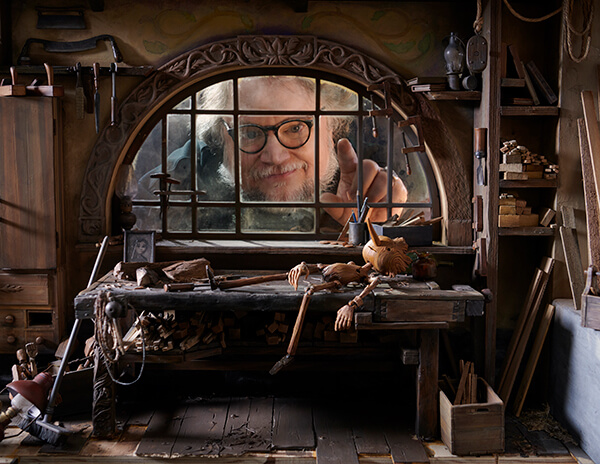
Guillermo del Toro on set (Image via Netflix)
This vision of Pinocchio very nearly went unrealised altogether, however. Beginning its life rooted in illustrator Gris Grimly’s striking reimagining of the character for a 2002 edition of Collodi’s original book (for which the Jim Henson Company had obtained the rights), in the decades that followed the project endured several dormant phases and an inscrutable lack of interest throughout the industry in spite of a filmmaker as celebrated as Guillermo del Toro’s attachment to it. During this lengthy period of stutter-starts and extensive story development Mark Gustafson, a noteworthy name in the stop-motion arena, came on board.
“I came in around 2010-2011, pretty early on,” recalls Mark, “It was just a phone call from Guillermo, he said ‘Mark, I’m doing this project-’ and I said ‘I’m in!’ before he’d told me what it was.”
As the final film clearly demonstrates, the coming together of Guillermo and Mark as joint directors would prove an ideal pairing, Guillermo having long admired Mark’s body of work that included a long stretch with Will Vinton Studios on such joyously nightmarish projects as The Adventures of Mark Twain and Return to Oz alongside its lighter fare that included The California Raisins and The PJs.
“Animation has always been something I not only study and collect but try to practice,” Guillermo enthuses, “Particularly in the last fifteen years or so. I started to come back to it through DreamWorks.
“As Mark says, clay or stop-motion is the one form of animation that you can do basically alone in your room. For some reason stop-motion attracts all those weirdos more than other forms of animation, don’t you think?”
“Absolutely.” Agrees Mark, “I remember probably my first experience with it wasn’t really stop-motion, but we would strap M-80s to the neighbour’s Barbie dolls and blow them up to see if we could get a picture at the moment that they were exploding.”
With this healthy bond established, the team would continue to develop the concept and, in turn, continue to be told ‘no’ in pitch meeting after pitch meeting. At the precipice of considering international financing, Guillermo would turn to a newer relationship he had established along the way in a final push to get their vision for Pinocchio off the ground.
“I, quite pointedly, said ‘Let’s try with Netflix’, because I had a great experience with them on Tales of Arcadia, and all the Troll Hunters, 3Below, Wizards – we did over eighty episodes, and it was really, creatively, very free.” With an ally in Netflix co-CEO Ted Sarandos, the team finally achieved the seemingly unachievable and got the film the green light that had eluded it for so long. “We pitched it to Ted and he said ‘yes’ in the room! It was very, very easy, because he knew from the designs and the pitch that this was going to be something special. It was a fantastic experience as expected and, creatively, we had complete autonomy.”
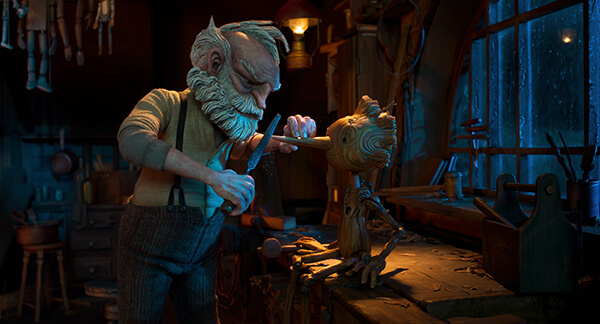
Guillermo del Toro’s Pinocchio – (L-R) Gepetto (voiced by David Bradley) and Pinocchio (voiced by Gregory Mann). Cr: Netflix © 2022
Of the many reasons this iteration stands apart (out of three film adaptations of what is ostensibly the same story this year alone), the one that shouts at the audience the loudest is its unflinching exploration of the subject of death, a theme that children’s films and literature has increasingly shied away from in more recent decades. This may ring familiar with those who have followed Guillermo’s prior forays into animation and the body count they have racked up.
“When I was at DreamWorks, Jeffrey Katzenberg called me the harbinger of death, because the mortality rate on the characters tripled since I joined! We had Puss in Boots, the first one, in which we essentially kill Humpty Dumpty. The second Puss in Boots, which I started developing with the team, deals precisely with mortality, it was Puss losing all his lives and making do with one – basically the philosophy I believe in. And, of course, the killing of the father in How to Train Your Dragon.” This impulse to confront such heavier themes rather than evade them or replace them with arbitrarily happy endings speaks to Guillermo’s respect for his audience and the full knowledge that children will likely be among them.
“When we were pitching the movie or presenting the movie, I would always get asked ‘Is it for kids?’ And I’d say ‘It’s not made just for kids, but kids can watch it.’ The world is very complex right now. Kids don’t want simple answers to a complex world, they want complex answers to understand a complex world. The other day in San Francisco, Quentin Tarantino said on stage that the most violent, scary movie he’d ever seen was Bambi. And he’s not wrong. Even Disney’s earlier Pinocchio, the reason I was attracted to it is because it was one film in my childhood that showed me somebody who understood how scary and fraught with danger childhood felt. It’s only in the later decades that animation became pasteurised and homogenised into something that doesn’t even have the elements of danger that fairytales traditionally have.”
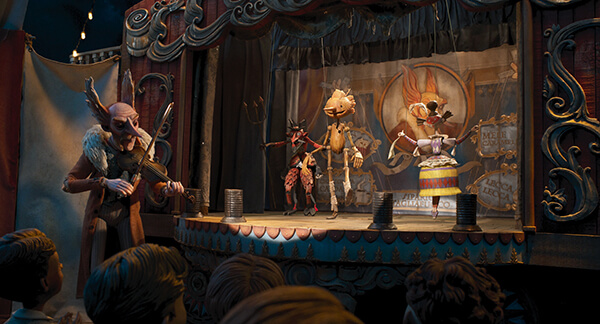
Guillermo del Toro’s Pinocchio – (L-R) Count Volpe (voiced by Christoph Waltz) and Pinocchio (voiced by Gregory Mann). Cr: Netflix © 2022
In some respects the film plays a little lighter than its source material, or at least it seems to; while Collodi’s Talking Cricket is smashed to death by a mallet early on in the novel, subsequently appearing as a ghost, del Toro and scriptwriting partner Patrick McHale (of Over the Garden Wall fame)’s Sebastian J. Cricket survives, only to endure a ceaseless, grimly comedic parade of pain and suffering in his efforts to steer Pinocchio right. Other deviations of note reframe the tale as a brutal and razor-sharp satire on fascism, relocating the time period to roughly a century later to take place during the rise of Mussolini, as well as thoughtful ruminations on fraught relationships between fathers and their sons and a fundamental eschewing of the notion that Pinocchio’s main driving force should be to become a ‘real’ boy. Instead he is imbued with an immortality that sees him dipping in and out of a beautifully-realised death realm occupied by bored, lagomorphic bureaucrats and the regal spectre of Death itself. The unique charm of this world’s Pinocchio himself is in his unfiltered nature that simultaneously exudes a happy-go-lucky passion for a world so new to him alongside a penchant for creating chaos and panic wherever he goes and a contrarian impulse he cannot curb in spite of his developing knowledge of right and wrong.
“The theme of disobedience being a virtue, which is counter to all the Pinocchios I knew as a kid, was there from the start.” Recalls Guillermo, “Then when I saw the Gris Grimly drawings, a whole world came with it – everything precipitated, setting it in fascist Italy…very quickly, it sort of just poured out, you know? I think the design unlocked all of that. I’d say, without Gris Grimly and his design, there would not be this movie.”
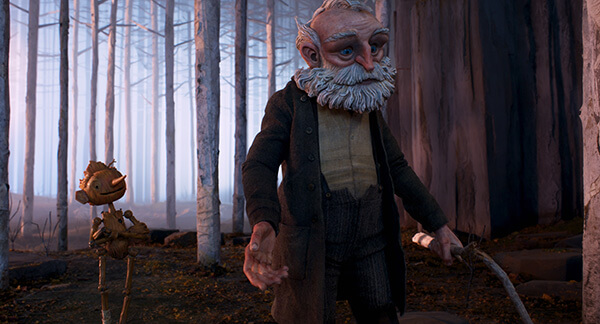
Guillermo del Toro’s Pinocchio – (L-R) Pinocchio (voiced by Gregory Mann) and Gepetto (voiced by David Bradley). Cr: Netflix © 2022
Although the original film concept based on Gris’s take on Pinocchio would ultimately go unmade, the artist remained a crucial presence in the subsequent pitches and overall development of the film. “Gris and I have a very good relationship; those who know Gris know he’s a really reasonable, noble guy. We had a very harmonious relationship when I was producing, and he, very harmoniously, understood that it was not going to happen with the version that existed then. For example, the political themes were not that present, the grief was not present, the loss, the realm of death, the idea that whatever happens, happens – and then we’re gone; none of that was there. From the moment I took the reins, I wanted it to be a piece with Devil’s Backbone and Pan’s Labyrinth. It started to be shaped by that, by the fact that it now belonged to a different universe, and it sort of follows that precept.”
Crucial to adapting Gris’s initial designs to a real-life, 3D space was production designer Guy Davis (The Shape of Water, Nightmare Alley), with UK studio Mackinnon and Saunders stepping up and creating the puppets with the incomparable quality previously established in their work on such films as The Corpse Bride, Fantastic Mr. Fox and Mars Attacks! on top of a plethora of celebrated series and commercials. While not responsible for fabricating the entire cast of characters, the Manchester-based team cemented the film’s style with the key players including Pinocchio, Geppetto and Sebastian J. Cricket, as well as the villainous Volpe, his beaten-down monkey Spazzatura and the brutal Podestà intent on harnessing Pinocchio’s immortality for military purposes. Combining several established approaches to stop-motion puppet fabrication with Guillermo’s own specifications for how the characters should be animated, the team developed an intricate system of gears and paddles that allowed animators control over facial animation that reduced the reliance on rapid prototyping – save for Pinocchio himself, for whom the process of 3D printed replacement animation best suited his wooden aesthetic. Crucial to striking the right note when it came to the look and performance abilities of the puppets, as well as their overall development, was Director of Character Fabrication Georgina Hayns, a veteran not just of Mackinnon & Saunders but Laika Studios, whose dedication to stop-motion film production has been significant in keeping interest in the medium alive.
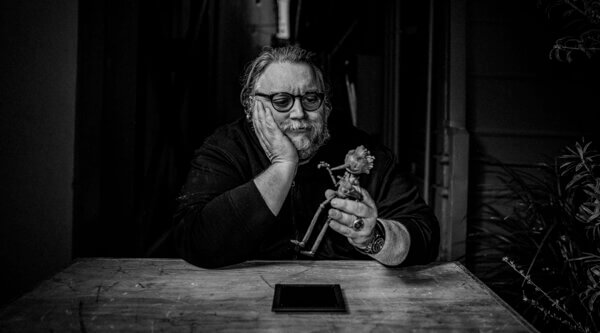
Guillermo del Toro pictured with Pinocchio (Cr. mandraketheblack.de/NETFLIX ©2020)
“MacKinnon and Saunders are the best puppet makers in the world,” enthuses Mark, “and Georgina worked with them, trained with them, so that was a really natural relationship. We handled about half the puppets in Portland at ShadowMachine and Mackinnon and Saunders did the bulk of the rest of them, and then some of the puppets were done in Guadalajara, the team down there who did the black rabbit sequence, which was really pretty cool.”
The combination of studios and teams make for a curiously diverse yet consistent overall aesthetic, one that builds on Gris’s original vision rather than outright replacing it. This seamless bringing together of design sensibilities that might perceivably be at odds with one another in a way that comes across as satisfying to the viewer is something stop-motion is uniquely tailored to.
“Talking the other day with Henry Selick, we were agreeing on the fact that nothing expresses the weird, the odd and ‘slanted’ like stop-motion.” Says Guillermo, “It really has that quality to bring things that are off-kilter to life.”
“Yeah, there’s a kind of ‘broken’ quality to it that I think attracts broken people – not to get too dramatic!” Adds Mark, “But you know, we’ve all got a little of that in us.”
To the palpable appreciation of the animation community at large, Guillermo himself has been a vocal advocate of animation and stop-motion being invaluable in filmmaking whilst not being dismissed or mislabeled as a ‘genre’. While the world at large seems to continue to grapple with that notion, the director is optimistic for how audiences and the wider industry will engage with animation as time goes on.
“It doesn’t matter if it happens this year, or in ten years, but it will happen.” Guillermo insists, “This is a battle that has been waged for a long, long time. The fact is, in the animation medium stop-motion most closely resembles live-action in terms of complexity, shooting with real sets, real actors, real props, real cinematography, there’s a lot of analogue things – but they’re even more complex because you do it frame-by-frame and in miniature.”
“I still think that what’s important is less the technique and more that real storytellers are getting ahold of this technique and starting to use it.” Mark adds, “I think that’s how it becomes legitimate and how people start recognising it as just another form of filmmaking and not some sort of oddity.
“As Guillermo likes to say, stop-motion is pronounced ‘dead’ every five years or so, people go ‘Well, that’s not coming back’ – and then somebody does something new or interesting with it. I mean, this year, we had (Henry Selick’s) Wendell & Wild, which is great, and (Phil Tippett’s) Mad God, and our film. I think it’s a vibrant forum right now and it has a bright future. The technology just enables us to hone it a little bit more, it makes it easier to actually do than it used to be, more people have access to that technology now, which is great.”
Pinocchio is out now on Netflix. Hear more from Guillermo del Toro and Mark Gustafson in episode 108 of the Skwigly Animation Podcast (direct download link) and to learn more about the film’s puppet fabrication read our interview with Puppet Supervisor Georgina Hayns and Production Designer Guy Davis.

